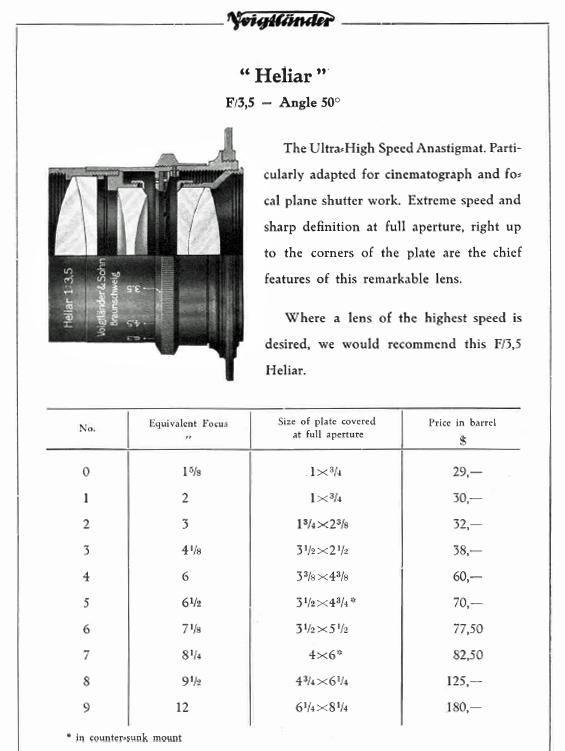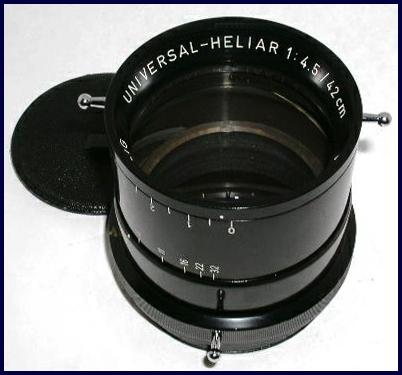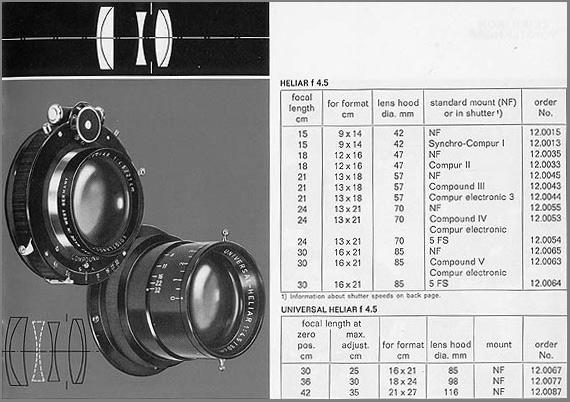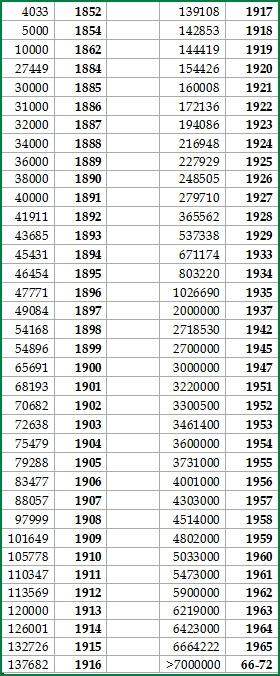| A Short History of the Heliar Lenses |
|
In 1900, Carl August Hans Harting filed a patent for what would be the first version of the now famous, Heliar lens. The Harting design was essentially a modification of the Cooke Triplet, with two additional elements and a symmetrical layout. These changes helped address the Triplet's short comings of longitudinal aberrations while still allowing for a wide (fast) aperture. The lens had a speed of f/4.5 and covered 50 degrees. Its large aperture made it suitable for portraiture and instantaneous work.
|
In 1902, Harting filed another patent for an updated of the Heliar lens. This version Heliar, as shown below, is no longer symmetrical in design. According to Rudolph Kingslake's "History of the Photographic Lens," the reason for the update may have been that the first version suffered from excessive astigmatism and a large Petzval Sum (curvature of field). Others mention that coma was also quite pronounced in this design.
|
During the first two decades of the twentieth century, the Heliar's reputation grew rapidly. However, Harting had never stopped tinkering with the 1902 version of the Heliar, and had, by 1903, revised the design again. Harting flipped the outer glass components around to have the (cemented curves) convex side, facing the aperture. Despite being an updated Heliar, this new lens was sold as the "Dynar" lens by Voigtlander. The design is shown below ( US Patent 756006 ):
|
In performance terms, the Dynar was superior to the Heliar in all aspects but astigmatism. Its speed was advertised at f/6 with 60 degrees of coverage, despite the design actually allowing for a much faster aperture. This was done as to not directly compete with the very popular and profitable Heliar. As such, Voigtlander continued to sell both the Heliar (1902 f/4.5 design) and the Dynar, side-by-side into the early 1920's.
About 1925, Voigtlander decided to tweak the Dynar design and created an f/3.5 lens with 50 degrees of coverage. This time, Voigtlander decided to go back to calling it a Heliar rather than continuing with the less popular "Dynar" name. Again, this made good commercial sense as the Heliar brand name had garnered a reputation of "prestige and mystique," according to the Lens Collectors Vade Mecum. Aside from its actual optical qualities, part of the Heliar's lore is related to Japanese Emperor Hirohito, who is claimed to have so admired the Heliar lens, that he would only allow his picture to be taken with a Heliar.
| |
|
<===== The new f/3.5 Heliar's optical layout
|
 |
| c. 1930 Advertisement for the new, faster Heliar: |
|
|
The f/4.5 version was advertised as suited for "...artistic portraiture and studio photography" where it is "unrivaled." The faster f/3.5 version Heliar was advertised as "particularly adapted for cinematograph and focal plane shutter work" and was sold mainly for medium format and some smaller large format images due to its reduced coverage. The f/3.5 lens was also 50% more expensive than the f/4.5 version.
|
About 1926, yet another Heliar lens was born, the f/4.5 "Universal-Heliar." This lens is identical to the 1902 f/4.5 version Heliar, however it features the ability of the central lens element to be adjusted by the user, thereby introducing varying amount of spherical aberrations. The lens has a ring which can select settings from zero to five. Zero to denote, no softness with "full definition," out to as much as five with the greatest possible softness added. The lens was apparently only sold in 4 sizes up until WWII; 300mm, 360mm, 420mm and 480mm. After the war, the 480mm was dropped from the line up.
|
 |
| Photo of a late model, coated Universal-Heliar 420mm f/4.5...Sold by Ebay User ID stardust06242 |
|
|
In 1942, Kodak lens designer, Fred Altman, designed 10 examples of Heliar-type lenses of varying focal lengths, speeds and coverage. One of these would become the 100mm f/3.5 Ektar lens for the Kodak Medalist. Altman's versions were all single coated, even on the inner lens elements. Altman's lenses were considered some of the finest camera lenses made to date.
|
After World War II, Voigtlander began single coating the Heliar lenses. Serial numbers starting about 2,7xx,xxx on, appear to be factory coated.
In 1949, A.W. Tronnier of Voigtlander, tweaked and recalculated the f/3.5 Heliar and created the 105mm f/3.5 Heliar with coated lenses (US Patent 2645156). This lens would be called the "Color-Heliar" and would live its most famous days mounted to the 6x9 cm Voigtlander Bessa II Rangefinder camera.
|
 |
| Early 60's Zeiss Ikon / Voigtlander Lens Catalog page showing Heliars still for sale. |
|
|
The collective Voigtlander Heliar lens versions would continue to be sold into the late 1960's and remained highly desired optics. Since the design's birth, more than a century ago, the trade name of "Heliar" has always carried with it an aura of quality, mystique and sophistication. It's this mythical-like appeal that continues to make Heliar lenses very desirable in the photographic marketplace. Its also why the trade name of Heliar was reborn in 1999, by the Japanese firm of Cosina. The rights to use the name Heliar (among others) was leased from Voigtlander/Ringfoto for Cosina's 35mm "Bessa" Rangefinder product line.
While the later Heliar lenses are certainly capable lenses, the power of marketing has ensured the name live on in photographic history.
|
|
Sources for Article:
Modern Lens Design
|
 |
| Voigtlander Serial Number & Date Chart |
|
|
|